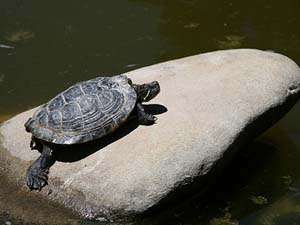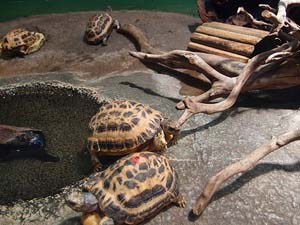
Close Up Photo of a Red Eared Slider — one of the most common turtle species that can be found in pet shops in Lucena CityPhoto by
Photo by Brent Myers
Turtles are some of the most common fixtures in local pet shops in Lucena City, with red-eared sliders taking the top spot for turtle specie commonly sold; however, while there are plenty of people who are willing to buy them, there aren’t as many people who know how to take care of them
Because of this, we thought of compiling a short guide on some of the most common things that you would need to remember if you’re going to raise a turtle. Do note, however, that these are just general tips and reminders and do not equal professional advice. For that, it’s still best if you’ll consult a local veterinarian.
Providing Living Spaces for Your Turtles
Turtles need sufficient space to move around in the same way humans do, so it is important that your home can accommodate a sizable space for a terrarium (if they are from a land-dwelling specie), an aquarium (if they are sea-dwelling), an outdoor pen, a pond, or a combination of any two of them. A good number of homes in Lucena have some backyard space, so you could probably build the pen, wading pool, and a small basking area in your yard.

A red-eared slider sitting on a slab of stone while basking in the sun.Photo by
Photo by Allan Hack
The technical specifications may vary depending on the size of your turtle, but for red-eared sliders, a ten-gallon aquarium with a basking area (can be made up of a sizable stone or wood slab where they can rest while soaking up heat and other essential nutrients from the sun) usually suffices for babies while 55-gallon tanks, also with a basking area, are usually enough for adults. For outdoor pens, an enclosure 8 x 8 feet in size should be enough to give your turtle ample space to roam around in.
Also, providing them with slightly rough ground to walk on will help keep their claws healthy and in good shape.
For more information about tanks, basking areas, and accessories that you can put in your turtle’s tank, please refer to the pages below:
What to Feed Your Turtle
Turtles are typically omnivorous, so they’ll be happy to eat whatever plants or small animals that they’d find lying around. Some examples of food that turtles love to it include vegetables (kangkong, lettuce, cabbage, squash), berries (alatiris, duhat, grapes) earthworms, snails, and a variety of small animals (earthworms, fishes, moths, caterpillars). These are readily available in Lucena, so you can find plenty of food for your turtle even if you have a limited budget.

Photo of a turtle munching on strawberries
Photo by Jurvetson
Make sure you don’t feed your turtle with food that has gone bad, though, because there’s a possibility that it might make them sick.
If you don’t have the time to collect natural food for your pet but you have some extra money to spare, you can also feed them with pellets for turtles that you can buy from your nearest pet shop.
How Often Should You Feed Your Turtle
The dietary requirements of turtles change as they age. For example, young land-based turtles are generally fed daily for the first two to three years. Growing aquatic turtles, on the other hand, are usually fed twice a day during active times. Young turtles are usually recommended to be fed with tiny treats distributed throughout the day.
You can find more information on how often and how much you should feed your turtle on the pages below:
How to Tell if Something is Wrong with Your Turtle
Animals can’t speak, so it’s often difficult to tell what they’re feeling; however, there are a couple of tell-tale signs that can tell you whether your turtle is still in tip-top shape or if it already needs medical attention.
Some common examples of these include swollen eyes, bulging eardrums, peeling skin, overgrown claws, soft and bumpy shells, persistent diarrhea, lack of appetite, excessive digging, and unresponsiveness to any form of stimuli. If your turtle starts displaying one or more of these signs, you might want to bring them to a local veterinarian for a medical check-up. If you need a specialist but you don’t know any, you could probably ask the pet shop where you bought your pet from for some referrals or for any helpful tips on how to take care of them.
For the meantime, some tips can be found here:
- Unusual Behavior and Symptoms
- Sick Turtle Summary
- Sick Red Eared Slider Help
Giving Your Pet Some Company

Photo of a turtle wandering around the yard
Photo by LaggedonUser
Turtles are not sociable creatures, so unless you want to keep two turtles of opposite sexes for mating purposes, keeping two turtles at the same time, especially at the same pen, is not recommended.
For one, the turtles may start fighting. Another thing, a meeker turtle may feel intimidated by the more dominant turtle and may stop eating properly due to stress, making its health suffer in the process. If you really want to keep two or more turtles, try to put as much space as you possibly can between them, so they won’t encroach on each other’s territory.
Also, as much as possible, try not to place young turtles together with cats, dogs, or other animals that might bite or crush them out of curiosity. Young turtles’ defense systems are not yet that strong at this age, so it might deal them some serious damage.
Raising a pet is like raising a child: it takes responsibility and commitment to do it well, so make sure you’re prepared for all the work that comes along with owning a pet before you buy or adopt your first turtle.
If you just like playing with turtles but you’re not willing to do all the work, it’s best if you’ll leave them in their natural habitat or just let someone with more knowledge and experience take care of them.
If you really want to have your own turtle but you don’t know how to take care of them, though, there are plenty of turtle owners on the internet that would be more than willing to answer whatever questions you may have. Some helpful links have been provided for you, but If you have other tips of your own or you know other similar sites, feel free to share them with us.
Additional References:
Wilke, H. (2009). My Turtle. Germany: Barron’s Educational Series, Inc.

 Philippine Peso
Philippine Peso